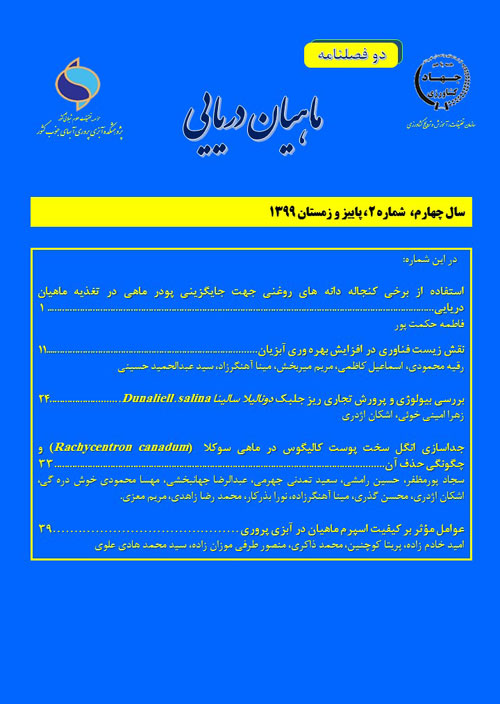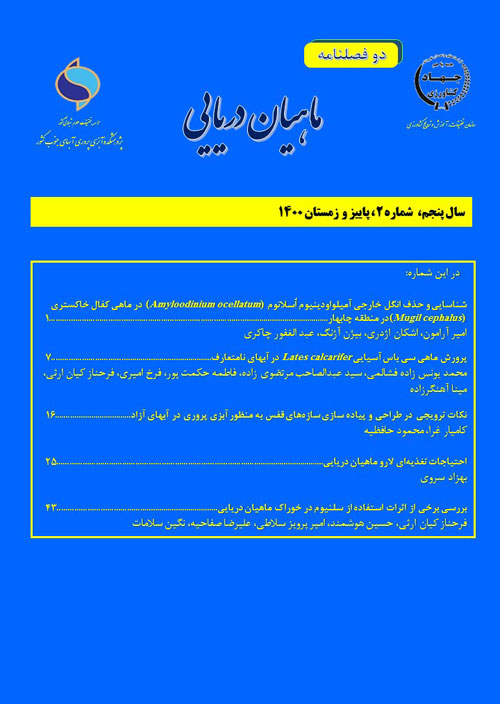فهرست مطالب

نشریه ماهیان دریایی
سال چهارم شماره 2 (پیاپی 5، پاییز و زمستان 1399)
- تاریخ انتشار: 1400/04/02
- تعداد عناوین: 5
-
صفحات 1-10پودر ماهی مهمترین منبع پروتئین جیره غذایی آبزیان گوشتخوار دریایی می باشد. با افزایش تولیدات صنعت آبزی پروری نیاز به این منبع پروتئین متقابلا افزایش یافته است. در حالی که در این سال ها، تامین ماهیان صید دورریز جهت تولید پودر ماهی کاهش چشمگیری یافت. کاهش دسترسی به پودر ماهی، افزایش تقاضا و در پی آن افزایش قیمت چالشی در مقابل پایداری و رشد صنعت آبزی پروری دریایی می باشد. براین اساس مطالعه در زمینه یافتن منابع جدیدپروتئین جهت جایگزینی کامل یا جزیی پودر ماهی به موضوعی حایز اهمیت در صنایع غذایی آبزیان مبدل شد. کنجاله دانه های روغنی ازجمله منابع پروتئین گیاهی با محتوای پروتئین متوسط (30 تا 50 درصد) هستند. استفاده از این کنجاله ها تا سطح 40 درصد جایگزینی پودر ماهی کارایی رشد، بازده تغذیه و اقتصادی قابل قیاس با جیره حاوی پودر ماهی در پی داشته است. کاهش سطح پودر ماهی به نصف در جیره غذایی آبزیان با استفاده از این کنجاله های با صرفه اقتصادی کاهش هزینه خوراک آبزیان را در پی دارد. براین اساس هزینه تولید آبزیان پرورشی کاهش می یابد و امکان توسعه پایدار صنعت آبزی پروری فراهم می شود.کلیدواژگان: تغذیه ماهیان دریایی، کنجاله دانه های روغنی، جایگزینی پودر ماهی، عوامل ضدتغذیه ای
-
صفحات 11-23با توجه به رشد جمعیت، تقاضا برای مصرف آبزیان در سراسر جهان افزایش می یابد و بعید به نظر می رسد که این افزایش تقاضا بتواند با افزایش برداشت آبزیان از اقیانوس ها و دریاها هماهنگ شود، چرا که برداشت و بهره وری در بسیاری از اقیانوس ها و مناطق صیادی آب های شیرین محدود شده است. بنابراین آبزی پروری آخرین امید برای فراهم نمودن آبزیان کافی در سراسر جهان می باشد که خود با محدودیت های زمین و آب کافی همراه است. ویژگی های خاص آبزیان نظیر قابلیت تحمل سطوح مختلف پلوییدی، لقاح خارجی، دوره رشد نسبتا کوتاه و حجم بالای گامت های استحصالی منجر به توسعه تکنولوژی های جدید در آبزی پروری گردیده است. بیوتکنولوژی می تواند نقش اساسی را در بهبود بازده آبزی پروری داشته باشد. استفاده از بیوتکنولوژی در سیستم های مختلف تولید بدون تاثیرات منفی نبوده ولی با این حال، خدمات و آثار مثبت آن بیش از نگرانی های مرتبط با آن است چرا که تکنیک ها دایما به منظور کاهش تاثیرات منفی آن در حال توسعه هستند. بنابراین برای دستیابی به امنیت غذایی در سطح جهان بکارگیری روش های بیوتکنولوژیکی لازم است.کلیدواژگان: جمعیت، آبزی پروری، بیوتکنولوژی، امنیت غذایی
-
صفحات 24-32ریزجلبک دونالیلا سالینا (Dunaliella salina)، که به عنوان مهمترین منبع تولید بتاکاروتن در طبیعت شناخته شده است، یک میکروارگانیسم یوکاریوتی منحصر بفرد است که دامنه تحمل بالایی در برابر نوسانات شرایط محیطی مانند شوری (0.5-5 مولار)، دما (20-40 درجه سانتی گراد) و نور (50 تا 1500 میکرومول بر ثانیه) دارد. این جلبک به دلیل داشتن ترکیبات فراسودمند مانند رنگدانه کارتنویید،گلیسرول و اسیدهای چرب غیراشباع فعالیت زیستی آنتی اکسیدانی، ضد سرطانی و ضد میکربی از خود نشان داده و به همین دلیل کاندید مناسبی برای استفاده در صنایع غذایی، دارویی و آرایشی می باشد. شرکت های مختلف در دنیا به تولید تجاری آن علاقمند شده و سیستم های متعددی را برای کشت انبوه آن طراحی و به کار گرفته اند که از جمله آن کشت در استخر های روباز بیرونی و یا فتوبیوراکتورهای بسته می باشد. با وجود مزیت های زیستی متعدد این ریز جلبک و تلاش های زیاد برای تولید انبوه آن در بسیاری از نقاط دنیا، همچنان موانعی بر سر راه تولید تجاری و مقرون به صرفه آن وجود دارد که بیشتر مربوط به فرآیندهای پایین دستی تولید شامل عملیات جمع آوری، خشک کردن و استخراج چربی و رنگدانه های تجاری آن می باشد.کلیدواژگان: ریزجلبک Dunaliella salina، سیستم تولید، بتاکاروتن، مزیا و موانع تولید
-
صفحات 33-38
شپش های دریایی تاکنون خسارت های جبران ناپذیری را به مزارع پرورش ماهی در دنیا وارد کرده اند. تقریبا حدود 54 درصد آلودگی ناشی از کپه پودها متعلق به شپش های دریایی می باشد. این انگل ها موجب زخم شدن پوست در نزدیکی سر می شوند و درصورت آلودگی زیاد مرگ و میر ماهی ها را به دنبال خواهد داشت. در این مطالعه تعداد 11 قطعه ماهی سوکلا با وزن های 5/0 تا 4/3 کیلوگرم از خلیج فارس صید و به تانک های قرنطینه ایستگاه تحقیقات نرم تنان خلیج فارس در بندر لنگه منتقل شدند. ماهیان با چشم غیرمسلح یا ذره بین دستی از لحاظ وجود انگل های خارجی بزرگ مورد بررسی قرار گرفتند که در نه قطعه وجود کالیگوس به ثبت رسید. در این مطالعه قسمت سر ماهی سوکلا دارای بیشترین تعداد کالیگوس بود. همچنین حضور این انگل در سایر نقاط همچون ناحیه سطح بدن، سرپوش آبششی، باله های پشتی، دمی و سینه ای مشاهده شد. بیشترین و کمترین تعداد نیز به ترتیب 156 عدد و 41 عدد بود. برای از بین بردن کالیگوس ها از آب شیرین به مدت 30 ثانیه و یا تری کلروفن با غلظت ppm 1 به مدت یک ساعت استفاده شد. در هر دو روش تانک ماهیان تعویض شد.
کلیدواژگان: کالیگوس، سوکلا، آب شیرین، تری کلروفن -
صفحات 39-50اسپرم ماهیان پس از رها شدن در محیط آب مدت زمان محدودی دارد تا بتواند به تخمک برسد، دو عامل محدود کننده برای لقاح موفق مدت زمان تحرک اسپرم تا رسیدن به تخمک و دیگر عامل محدود کننده زمان بسته شدن سوراخ میکروپیل تخمک است. کیفیت اسپرم یکی از عوامل مهم در تولیدمثل است که خود این عامل تحت تاثیر پارامترهای مختلفی نظیر زمان تحرک، سرعت اسپرم، اسمولاریته، غلظت اسپرم در منی و ATP می باشد. علاوه بر این، پارامتر های تغذیه ای نظیر ویتامین ها، مواد معدنی و اسیدهای چرب در افزایش کیفیت اسپرم دخیل هستند. حال بررسی پارامترها و عوامل موثر در کیفیت اسپرم بسیار حایز اهمیت است، چراکه تولیدمثل و تکثیر ماهیان جز حلقه های مهم تولید در آبزی پروری است. همچنین مطالعات در مورد ماهیان دریایی نسبت به ماهیان آب شیرین بسیار کمتر هستند و تحقیقات در این زمینه در جهت آبزی پروری پایدار لازم است.کلیدواژگان: کیفیت اسپرم، زمان تحرک، سرعت اسپرم، مواد معدنی، آبزی پروری پایدار
-
Pages 1-10Fish meal is the most important protein source in the marine carnivorous fish diet. The need for this protein source has increased with the increase in aquaculture industry production, reciprocally. During these years, the supply of trash fish to produce fish meal decreased significantly. Reduced access to fishmeal and rising demand, followed by increasing prices, is a challenge to the sustainability and development of the marine fish culture. Accordingly, the study of finding new protein sources for complete or partial replacement of fish meal has become an important issue in the fish nutrition industry. Oilseed meal is one of the plant protein sources with moderate protein content (30 -50%). The use of oilseed meal up to 40% replacement of fish meal has resulted in growth performance, feed and economic efficiency comparable to diets containing fish meal as the main protein source. Decreasing the half level of fish meal in the marine fish diet by using this economical meal reduces the cost of formulated feed. Therefore, the cost of marine fish culture will be reduced, and the possibility of sustainable development of this industry will be provided.Keywords: Marine fish nutrition, Oilseed meal, cake, Fish meal replacement, anti-nutritional factors
-
Pages 11-23Due to the growing population of the world, the demand for fish is increasing worldwide. It seems unlikely that the increasing demand can be coordinated by increasing harvests of fish from the oceans and natural freshwater as harvesting and productivity in this area is limited. So, aquaculture remains the last hope for providing enough fish for the world, limited by land and water. Specific characteristics of aquatic species such as tolerance to different ploidy levels, external fertilization, relatively short growth period and high volume of extracted gametes have led to further genetic development in aquaculture. Biotechnology can play an essential role in improving aquaculture efficiency. The application of biotechnology to various production systems does not come without its negative effects but even still, the merits far outweigh the associated concerns because the techniques are constantly being developed, thereby reducing the negative impacts thereof. Therefore, there is a need to adopt biotechnological practices if the world is to stand any chance of achieving food security.Keywords: population, Aquaculture, biotechnology, Food security
-
Pages 24-32Microalgae Dunaliella salina, known as the most important source of beta-carotene production in nature, is a eukaryotic microorganism that has a high tolerance range for fluctuations in environmental conditions such as salinity (0.5-5 M), temperature (20-40 C°) and light (50 to 1500 μmol m-2 s-1). This alga has shown antioxidant, anti-cancer and antimicrobial activity due to their beneficial compounds such as carotenoid pigment, glycerol and unsaturated fatty acids, and are therefore a good candidate for use in the food, pharmaceutical and cosmetic industries. Various companies around the world have become interested in its commercial production and have designed and used several systems for its mass cultivation, including cultivation in outdoor ponds or indoor photo bioreactors. Despite the many biological benefits of this microalgae and the efforts to mass-production of this microalgae, there are still barriers to its commercial and cost-effective production. These challenge are mostly related to downstream production processes including harvesting, drying and oil and commercial pigments extraction.Keywords: Microalgae Dunaliella salina, Production system, Beta-carotene, Benefits, challenge of production
-
Pages 33-38
Sea lice caused serious harm to cultured marine finfish in the world. 54% of copepod infestations in marine fishes associated with outbreaks of sea lice. This parasite caused skin lesions near the head, and high infection can result in fish death. Eleven wild cobia with weight ranging from 0.5 to 3.4 kg were collected from the Persian Gulf and transferred to quarantined tanks at Persian Gulf Mollusks Research Station. The fish were examined for any existence of external parasites by the naked eye. And, caligus were found in nine cobia. The highest caligus density was recorded on the head. Furthermore, this parasite was found on the body surface, operculum, fins (dorsal, pelvic, and pectoral). The maximum and minimum caligus densities were 156 and 41, respectively. Trichlorfon (1 ppm for 60 min) or freshwater (0.5 min) were applied by the bath to kill sea lice. In both methods, the fish tanks were changed.
Keywords: Caligus, Cobia. Freshwater, Trichlorfon -
Pages 39-50After being released into the aquatic environment, fish sperm have a limited time to reach the egg, two limiting factors for successful fertilization are the time it takes for the sperm to reach the egg and the other limiting time for the micropile hole to close. Sperm quality is one of the important factors in reproduction, which itself is influenced by various parameters such as motility time, sperm rate, osmolarity, sperm concentration in semen and ATP. In addition, nutritional parameters such as vitamins, minerals and fatty acids are involved in increasing sperm quality. It is very important to study the parameters and factors affecting sperm quality, because reproduction and reproduction of fish is one of the important production links in aquaculture. Also, studies on marine fish are much less than freshwater fish, and research in this area is needed for sustainable aquaculture.Keywords: Sperm quality, motility time, sperm velocity, Minerals, sustainable aquaculture


